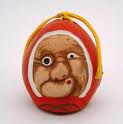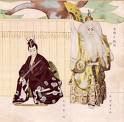:::::::::::::::::::::::::::::::::::::::::::::::::::::::::::::::::::::::::::::::::::::::::::::::::::
Ota Dokan Memorial Day
***** Location: Japan
***** Season: Early Autumn
***** Category: Observance
*****************************
Explanation
DOOKAN, Ota Dokan, Oota Dookan 太田道灌
(1432-1486)
Died 文明18年7月26日(1486年8月25日 August 25)

:::::::::::::::::::::::::::::::::::::::::::::::::::::::::::::::::::::::::::::::::::::::::::::::::::
observance kigo for early autumn
Dookan Ki 道灌忌 (どうかんき) Dokan Memorial Day

The famous monomizuka is at the temple Hongyo-Ji 本行寺, see haiku below.
Dookan monomizuka 道灌物見塚.
:::::::::::::::::::::::::::::::::::::::::::::::::::::::::::::::::::::::::::::::::::::::::::::::::::
Ōta Dōkan 太田 道灌
1432 - August 25, 1486
also known as Ōta Sukenaga (太田 資長) or Ōta Dōkan Sukenaga, was a Japanese samurai warrior-poet, military tactician and Buddhist monk. Ōta Sukenaga took the tonsure as a Buddhist priest in 1478, and he also adopted the Buddhist name, Dōkan, by which is known today.
Dōkan is best known as the architect and builder of Edo Castle (now the Imperial Palace) in 1457, in what is today modern Tokyo; and he is considered the founder of the castle town which grew up around that Ōnin era fortress.
Dōkan met an untimely end at Uesugi Sadamasa's home in Sagami (modern-day Kanagawa) after he was falsely accused of disloyalty during a period when the Uesugi family struggled through an internal clan conflict. His death poem is as follows:
Kakaru toki
sakoso inochi no
oshikarame
kanete nakimi to
omoishirazuba
Had I not known
that I was dead
already
I would have mourned
the loss of my life.
[Tr. Yoel Hoffmann]
Following his death, the castle was then abandoned until it was taken over by Tokugawa Ieyasu in 1590.
Dōkan's residence in Kamakura became Eisho-ji, a Buddhist temple.
:::::::::::::::::::::::::::::::::::::::::::::::::::::::::::::::::::::::::::::::::::::::::::::::::::::

Dokan Festival in Isehara, Kanagawa
伊勢原道灌祭り Dookan Matsuri
Second Weekend in October
Visiting Dokan Ohta
This tour course combines several tourist sites in Tokyo and two other prefectures, in relation to the historical figure, Dokan Ohta. Experiencing the local culture through food, festivals, and other facets is a shortcut to the rediscovery of these areas!
source : www.funade.jp
The remains of his old residence can be visited at
Mount Dokan, Dokanyama 道灌山, a favorite spot for visitors even in the Edo period.
See woodblock prints below.
*****************************
Things found on the way

'Yamabuki-no-Mino"
The warrior Ota Dokan Sukenaga (1432-1486) was caught in a rain storm and sought refuge at a rundown mill. The owner's daughter, instead of bringing him a rain coat, brought a fan decorated with yellow mountain rose flowers yamabuki, making reference to the stylized five petal flower design on his family crest mon, seen on his left sleeve.
. Ota Dokan and the Flower Maiden
- quote
Yamabuki no Sato 山吹の里 Yamabuki village
There have from times past been a number of theories about the location of Yamabuki village, which is famous for its legend about Ōta Dōkan.
Building upon these theories, the "Guide to Famous Edo Sites" says that according to oral legends,
Yamabuki village was deemed to have been situated
in the north of 高田馬場 Takatanobaba.
. source - Tokyo Metropolitan Library.
- quote
Ōta Dōkan 太田持資 (Mochisuke 1432-1486)
He was a general from the Muromachi period and a chief retainer of
the 扇谷 Ogigayatsu 上杉氏 Uesugi family.
From 1456 to 1457, he engaged in the construction of Edo Castle.
This painting shows Dōkan enjoying poetry in 静勝軒 Seishōken built as his residence in Edo Castle.
The western part of the Seishōken was called the 含雪 "Gansetsu" and
the eastern part was called the 泊船 "Hakusen."
. source - Tokyo Metropolitan Library.

by Ogata Gekkō (1859-1920) Ogata Gekko
- source : facebook
.................................................................................

. Edo Castel, Edo joo 江戸城
The History of Edo Castle
. Edo, The City That Became Tokyo
. 100 Favorite Dishes of Edo 江戸料理百選
. Tokyo - Local Dishes
*****************************
HAIKU

陽炎や道潅どのの物見塚
kageroo ya Dookan dono no monomizuka
heat shimmers -
the look-out hill
of Ota Dokan
Kobayashi Issa
In the year 1811 Issa went to visit the temple Hongyo-Ji 本行寺 (Hongyooji) in Arakawa ward, Tokyo (Edo at the time) on Januray 29th. Now there is only a stone memorial where Dokan built his first look-out for enemies.
. . . . .
In this haiku, Issa pays tribute to Ota Dokan - the Monomizuka must still have existed when he came here. But all the same, a sandhill is not much as the sole remembrance of the founder of Edo and in the summer heat Issa only sees a column of shimmering, hot air.
Ad G. Blankestijn, Japan.
. Heat Shimmers and Haiku
:::::::::::::::::::::::::::::::::::::::::::::::::::::::::::::::::::::::::::::::::::::::::::::::::::::
- quote -
Listening to the Insects at Dōkan-yama
Dōkan-yama (around the present day 4-chome Nishinippori, Arakawa Ward) was in the Edo period a popular place for insect savants who liked to hear the noise insects make ('mushi-kiki') and attracted many more people as a cool evening spot.
Dōkan-yama was not the only place popular for mushi-kiki; there was also Sumida River's east bank as well as Ōji and Asukayama.
The type of chirping insects would vary depending on the location and so people seem to have differenciated these places according to their mood, for example, when they wished to hear crickets they would go to Asukayama and would go to Dōkan-yama when they fancied hearing the sound of pine crickets. Such was peoples' interest at the time in the sound of insects and as there were also people who wanted to keep insects as pets in their homes, there were insect sellers who walked the streets carrying their wares in bamboo caskets.
During the Edo period, the Dōkan-yama is said to have offered views such as mountain ranges of Tsukuba and Nikko and Shimosa-no-kuni kōnodai.
Aside from this illustration, there are many more remaining works depicting 'mushi-kiki' in Dōkan-yama.
- source : Tokyo Metropolitan Museum -

Dokanyama, Utagawa Hiroshige
稲の花道灌山の日和かな
ine no hana Dookanyama no biyori kana
rice blossoming -
a fine day to visit
Mount Dokan
. Masaoka Shiki 正岡子規
age 28

Dokanyama and fireflies, Hiroshige
*****************************
Related words
***** . Memorial Days in Autumn
. Welcome to Edo 江戸 ! .
BACK : Top of this Saijiki
:::::::::::::::::::::::::::::::::::::::::::::::::::::::::::::::::::::::::::::::::::::::::::::::::::::::::::::::::::::::::::
[ . BACK to DARUMA MUSEUM TOP . ]
[ . BACK to WORLDKIGO . TOP . ]
- ##otadokan #dokan #dokanyama -
:::::::::::::::::::::::::::::::::::::::::::::::::::::::::::::::::::::::::::::::::::::::::::::::::::::::::::::::::::::::::::















































